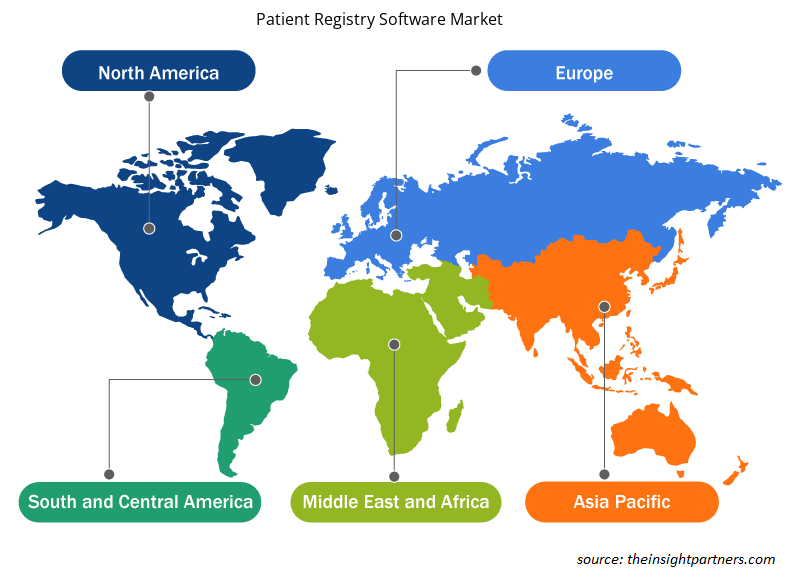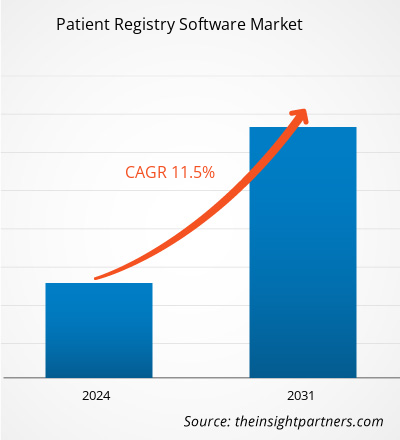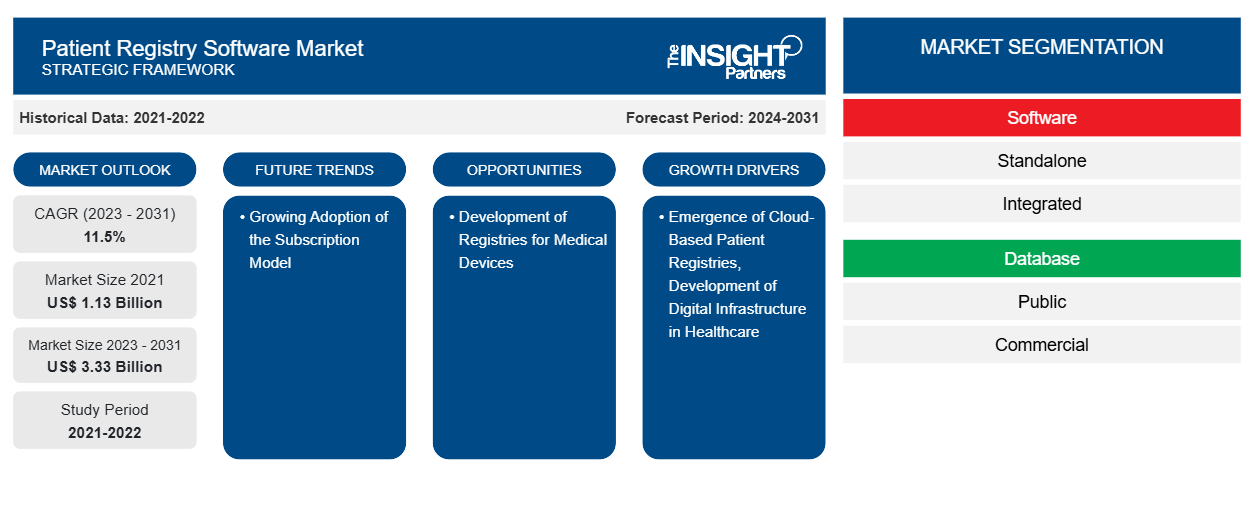La dimensione del mercato del software di registro pazienti nel 2021 era di 1,13 miliardi di $ USA e si prevede che raggiungerà i 3,33 miliardi di $ USA entro il 2031. Si prevede che il mercato registrerà un CAGR dell'11,5% nel 2023-2031. È probabile che lo sviluppo di registri per dispositivi medici rimanga una tendenza chiave del mercato del software di registro pazienti.
Analisi di mercato del software di registro dei pazienti
Si prevede che la crescente prevalenza di malattie croniche a livello globale sosterrà la crescita del mercato. La necessità di cartelle cliniche elettroniche (EHR) è aumentata notevolmente a causa della crescente prevalenza di diabete, malattie cardiovascolari, cancro e altre malattie. Il settore sanitario sta subendo una notevole trasformazione a seguito della crescente pressione per ridurre i costi, dell'implementazione di iniziative governative favorevoli e della crescente accessibilità ai social media e alle tecnologie mobili. Si prevede che tutti questi fattori favoriranno il mercato del software di registro dei pazienti durante il periodo di previsione. EHR) has increased substantially due to the rising prevalence of diabetes, cardiovascular disease, cancer, and other illnesses. The healthcare industry is undergoing a noteworthy transformation as a result of mounting pressure to reduce costs, the implementation of favorable government initiatives, and growing accessibility to social media and mobile technologies. These all factors are anticipated to benefit the patient registry software market during the forecast period.
Panoramica del mercato del software di registro dei pazienti
Il software di registro pazienti contiene database che vengono mantenuti tramite la raccolta di dati secondari relativi alla diagnosi, alla procedura o alle condizioni di un paziente, per registrare il numero di nuovi dispositivi medici utilizzati o sottoposti a una nuova procedura. Il software di registro pazienti è fondamentale nella sorveglianza post-marketing dei prodotti farmaceutici. A dicembre 2020, l'Unione Europea ha assegnato 66 milioni di dollari USA a diversi progetti di salute digitale con l'obiettivo di combattere le crisi sanitarie, come la pandemia di COVID-19, e di stabilire infrastrutture digitali e di intelligenza artificiale in Europa. L'assistenza finanziaria incoraggia le aziende di salute digitale a sviluppare e introdurre prodotti avanzati nel mercato del software di registro pazienti. Pertanto, la crescente incorporazione di strumenti digitali nella struttura sanitaria spinge la crescita del mercato.
Personalizza questo report in base alle tue esigenze
Riceverai la personalizzazione gratuita di qualsiasi report, comprese parti di questo report, o analisi a livello nazionale, pacchetto dati Excel, oltre a usufruire di grandi offerte e sconti per start-up e università
-
Scopri le principali tendenze di mercato in questo rapporto.Questo campione GRATUITO includerà analisi di dati che spaziano dalle tendenze di mercato alle stime e alle previsioni.
Driver e opportunità di mercato per il software di registro dei pazienti
L'emergere dei registri dei pazienti basati sul cloud guida la crescita del mercato
Gli EHR basati su cloud o basati sul Web sono stati utilizzati da medici indipendenti negli ultimi anni. Diverse organizzazioni stanno creando e sviluppando registri basati su cloud per numerose condizioni e procedure mediche. Ad esempio, l'Orphan Disease Center ha collaborato con Pulse Infoframe , un'azienda di informatica medica, per creare una serie di registri di pazienti con malattie rare su tecnologie basate su cloud. Allscripts insieme a Northwell Health ha firmato un accordo innovativo per generare l' EHR di prossima generazione nell'ottobre 2019. L'iniziativa supporta un'enorme generazione di entrate. Inoltre, i servizi software basati su cloud sono efficienti da utilizzare in termini di costi poiché devono essere pagati solo per i servizi e i registri richiesti. Pertanto, l'emergere di registri di pazienti basati su cloud sta guidando l'espansione del mercato.
Crescente adozione del modello di abbonamento per favorire la crescita del mercato
Il modello di abbonamento riduce al minimo i costi iniziali e allevia la pressione sui sistemi sanitari, perché non c'è bisogno di personale IT. Di conseguenza, aumentano l'economicità e la produttività. Per raggiungere potenziali clienti e consumatori in modi nuovi, questo modello consente anche ai venditori di creare modelli di licenza innovativi e creativi. Il software con modelli di abbonamento sta diventando sempre più popolare tra i fornitori di servizi sanitari poiché consente un time-to-value più rapido per qualsiasi nuova funzionalità aggiunta al programma, e può anche essere utilizzato per un periodo di tempo limitato, a seconda delle esigenze. Il modello di abbonamento è anche promosso da diversi attori del settore poiché offre una maggiore opportunità di sviluppare fiducia e comprendere le esigenze dei fornitori di servizi sanitari, migliorando in definitiva la soddisfazione del cliente. Questi vantaggi offrono opportunità di espansione agli attori del mercato, alimentando così la crescita del mercato durante il periodo di previsione.
Analisi della segmentazione del rapporto di mercato del software di registro dei pazienti
I segmenti chiave che hanno contribuito alla derivazione dell'analisi di mercato del software per i registri dei pazienti sono il software, il database, il tipo di registro, la modalità di fornitura e il modello di prezzo.
- In base al software, il mercato del software di registro pazienti è diviso in autonomo e integrato. Il segmento integrato ha detenuto la quota di mercato maggiore nel 2023 e si prevede che registrerà il CAGR più elevato durante il periodo di previsione.
- In base al database, il mercato è segmentato in pubblico e commerciale. Il segmento commerciale ha detenuto la quota maggiore del mercato nel 2023 e si prevede che registrerà il CAGR più elevato durante il periodo di previsione.
- In termini di tipo di registro, il mercato è categorizzato in registro prodotti, registro malattie, registro servizi sanitari. Il segmento registro malattie ha detenuto la quota di mercato più grande nel 2023 e si prevede che registrerà il CAGR più alto durante il periodo di previsione.
- In base alla modalità di distribuzione, il mercato del software di registro pazienti è suddiviso in on-premise e basato su cloud. Il segmento basato su cloud ha detenuto la quota di mercato maggiore nel 2023 e si prevede che registrerà il CAGR più elevato durante il periodo di previsione.
- In base al modello di prezzo, il mercato è segmentato in abbonamento, proprietà. Il segmento dell'abbonamento ha detenuto la quota maggiore del mercato nel 2023 e si prevede che registrerà il CAGR più elevato durante il periodo di previsione.
Analisi della quota di mercato del software di registro dei pazienti per area geografica
L'ambito geografico del rapporto di mercato sui software per i registri dei pazienti è suddiviso principalmente in cinque regioni: Nord America, Asia Pacifico, Europa, Medio Oriente e Africa, e Sud e Centro America.
Il Nord America ha dominato il mercato del software di registro pazienti. Il mercato del Nord America si sta espandendo a causa di diversi fattori, tra cui le consolidate cartelle cliniche elettroniche, l'evoluzione dell'infrastruttura digitale nell'assistenza sanitaria e la crescente consapevolezza dei pazienti riguardo ai vantaggi dei registri pazienti. È probabile che il mercato del software di registro pazienti nella regione aumenti con la presenza di vari attori chiave nel mercato che acquisiscono fornitori regionali e collettori di registri in modo da rafforzare le loro posizioni esistenti. Inoltre, l'obbligo da parte delle autorità federali di integrare l'uso di strumenti digitali nelle operazioni sanitarie per espandere la qualità e ridurre i costi allo stesso tempo è anche responsabile dell'aumento della crescita del mercato nella regione. Si prevede che l'Asia Pacifica crescerà con il CAGR più elevato nei prossimi anni. È probabile che il mercato assista a una crescita considerevole nella regione a causa dell'emergere di hub medici nella regione, della crescita del settore IT sanitario, della crescente enfasi sulla salute digitale, dell'attenzione alla semplificazione dei processi e delle politiche governative di supporto.
Approfondimenti regionali sul mercato del software per i registri dei pazienti
Le tendenze regionali e i fattori che influenzano il mercato del software di registro dei pazienti durante il periodo di previsione sono stati ampiamente spiegati dagli analisti di Insight Partners. Questa sezione discute anche i segmenti e la geografia del mercato del software di registro dei pazienti in Nord America, Europa, Asia Pacifico, Medio Oriente e Africa e America meridionale e centrale.

- Ottieni i dati specifici regionali per il mercato del software di registro dei pazienti
Ambito del rapporto di mercato del software di registro dei pazienti
| Attributo del report | Dettagli |
|---|---|
| Dimensioni del mercato nel 2021 | 1,13 miliardi di dollari USA |
| Dimensioni del mercato entro il 2031 | 3,33 miliardi di dollari USA |
| CAGR globale (2023-2031) | 11,5% |
| Dati storici | 2021-2022 |
| Periodo di previsione | 2024-2031 |
| Segmenti coperti |
Per software
|
| Regioni e Paesi coperti |
America del Nord
|
| Leader di mercato e profili aziendali chiave |
|
Densità dei player del mercato del software di registro dei pazienti: comprendere il suo impatto sulle dinamiche aziendali
Il mercato del software Patient Registry sta crescendo rapidamente, spinto dalla crescente domanda degli utenti finali dovuta a fattori quali l'evoluzione delle preferenze dei consumatori, i progressi tecnologici e una maggiore consapevolezza dei vantaggi del prodotto. Con l'aumento della domanda, le aziende stanno ampliando le loro offerte, innovando per soddisfare le esigenze dei consumatori e capitalizzando sulle tendenze emergenti, il che alimenta ulteriormente la crescita del mercato.
La densità degli operatori di mercato si riferisce alla distribuzione di aziende o società che operano in un particolare mercato o settore. Indica quanti concorrenti (operatori di mercato) sono presenti in un dato spazio di mercato in relazione alle sue dimensioni o al valore di mercato totale.
Le principali aziende che operano nel mercato del software per i registri dei pazienti sono:
- Società a responsabilità limitata
- Clinica Evado
- Cedro
- Società IBM
- FIGmd Inc.
- Medstreaming
Disclaimer : le aziende elencate sopra non sono classificate secondo un ordine particolare.

- Ottieni la panoramica dei principali attori del mercato dei software per registri dei pazienti
Notizie di mercato e sviluppi recenti del software di registro dei pazienti
Il mercato del software di registro pazienti viene valutato raccogliendo dati qualitativi e quantitativi dopo la ricerca primaria e secondaria, che include importanti pubblicazioni aziendali, dati di associazioni e database. Di seguito è riportato un elenco degli sviluppi nel mercato del software e delle strategie di registro pazienti:
- Seqster PDM, Inc., la principale azienda di tecnologia sanitaria incentrata sul paziente, ha stipulato una partnership pluriennale con la National Pancreas Foundation, per creare il più grande e inclusivo registro di pazienti con malattie pancreatiche del paese. Il nuovo registro innovativo basato su Seqster si collega a qualsiasi EHR, test del DNA genomico e dispositivo di monitoraggio indossabile/remoto, fornendo ai pazienti una cartella clinica longitudinale completa in tempo reale. (Fonte: Seqster PDM, Inc., comunicato stampa, 2022)
- L'American Academy of Pediatrics ha scelto ArborMetrix come partner per sviluppare e far crescere un registro clinico per migliorare la salute, il benessere e lo sviluppo di tutti i bambini. Il programma, il Child Health Improvement through Longitudinal Data (CHILD) Registry, supporta i 67.000 pediatri membri dell'AAP nel migliorare la salute dei bambini attraverso l'uso di dati del mondo reale. Raccoglie, archivia e analizza in modo sicuro i dati sanitari dei bambini negli Stati Uniti. (Fonte: ArborMetrix, comunicato stampa, 2020)
Copertura e risultati del rapporto di mercato sul software di registro dei pazienti
Il rapporto "Dimensioni e previsioni del mercato del software di registro dei pazienti (2021-2031)" fornisce un'analisi dettagliata del mercato che copre le seguenti aree:
- Dimensioni e previsioni del mercato a livello globale, regionale e nazionale per tutti i segmenti di mercato chiave coperti dall'ambito
- Dinamiche di mercato come fattori trainanti, vincoli e opportunità chiave
- Principali tendenze future
- Analisi dettagliata delle cinque forze PEST/Porter e SWOT
- Analisi di mercato globale e regionale che copre le principali tendenze di mercato, i principali attori, le normative e gli sviluppi recenti del mercato
- Analisi del panorama industriale e della concorrenza che copre la concentrazione del mercato, l'analisi della mappa di calore, i principali attori e gli sviluppi recenti
- Profili aziendali dettagliati
- Analisi storica (2 anni), anno base, previsione (7 anni) con CAGR
- Analisi PEST e SWOT
- Valore/volume delle dimensioni del mercato - Globale, Regionale, Nazionale
- Industria e panorama competitivo
- Set di dati Excel
Report recenti
Rapporti correlati
Testimonianze
Motivo dell'acquisto
- Processo decisionale informato
- Comprensione delle dinamiche di mercato
- Analisi competitiva
- Analisi dei clienti
- Previsioni di mercato
- Mitigazione del rischio
- Pianificazione strategica
- Giustificazione degli investimenti
- Identificazione dei mercati emergenti
- Miglioramento delle strategie di marketing
- Aumento dell'efficienza operativa
- Allineamento alle tendenze normative























 Ottieni un campione gratuito per - Mercato del software di registro dei pazienti
Ottieni un campione gratuito per - Mercato del software di registro dei pazienti